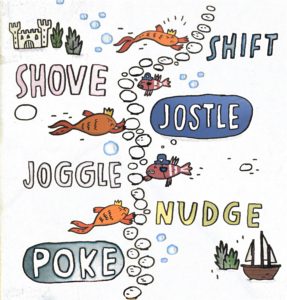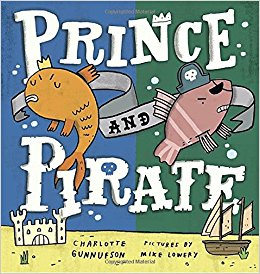If you know me, you know I am on an octopus/sea life kick. I tend to fixate for a short amount of time and then I’m off in a drastically different direction. So, Prince and Pirate is part of my sea life kick. Plus, it had a pirate fish on the front! I couldn’t help but giggle.
Why I Finished It:
I fully admit I had a feeling Prince and Pirate was just going to be a ridiculous story that would amuse me for a short time and not much more. I was wrong. Between the proper prince fish, the rough-around-the-edges pirate fish, and their fight to be the ruler of the new tank, it was impossible to stop reading. As I read (out loud to myself because I’m a little weird) I found myself putting on a pirate voice. It wasn’t good because I am no voice-over actor, however, the word choice by Gunnufson almost forces the reader to put on their best pirate accent. The second time I read it, my teacher’s brain went nuts with strong vocabulary and voice!
Who I Would Give It To:
Parents of young children and elementary writing teachers. At a minimum, Prince and Pirate is a good time. This is a fun, sit in my lap and let’s read a story (with accents of course) book. It is also a strong mentor text for elementary writing teachers!
Integration Ideas:
Writing – Word Choice/ Reading Strategy – Vocabulary and Visualization
 Oh, the vocabulary in this picture book! It is phenomenal! Some of the word choice in Gunnufson’s writing is to help with the character’s voice, so we’ll speak of that later in the post. The rest of the vocabulary really illustrates for students how there are so many words to choose from in the English language. Do they want their character to stroll, lumber, skip, dawdle, etc.? There are two pages in this book that look like the page to the right. *Swoon*
Oh, the vocabulary in this picture book! It is phenomenal! Some of the word choice in Gunnufson’s writing is to help with the character’s voice, so we’ll speak of that later in the post. The rest of the vocabulary really illustrates for students how there are so many words to choose from in the English language. Do they want their character to stroll, lumber, skip, dawdle, etc.? There are two pages in this book that look like the page to the right. *Swoon*
I love my kids to be moving and involved in learning, so I after I read the story once for fun I returned to this page and displayed it for everyone to see. I gave each student a pebble and we practiced moving the pebble according to the words on the page. We discussed as a class how shoving a pebble is much different from jostling a pebble. We said the words, acted the words and discussed the words. Guess what? Not only are we talking word choice now, the students also walked away with five new vocabulary words that they understood and retained!
Since we want the students to think about word choice in their own writing, the next step is to challenge the students to use stronger words in their own writing. I had my students highlight a verb in their writing. They went to the thesaurus to see other choices. They chose three they liked and then had to discuss the choices with their tablemates. The discussion had to include why they thought it was a good choice for their writing. The tablemates gave their own thinking on which word would be best and then the writer chose one and revised their writing. Happy moment – the students had so much fun doing this, many students changed multiple words in their writing.
Writing Conventions – Quotations
Prince and Pirate has so much dialogue that it would be a great mentor text to help students know how to write dialogue properly in their own writing. I like to put quotes from the book up on the board and have students share what they notice. I ask them to think about where commas are, where the quotation marks are placed, etc. Through discussion, the students are really thinking and processing the proper placement of commas, quotation marks, capital letters, etc. Once they have discussed, create an anchor chart with the rules. Then have students fix dialogue in their own writing or add at least one piece of dialogue to their writing.
Writing Trait – Voice!
Let’s acknowledge the elephant in the room – voice is hard to teach! It is, but let’s see what we can do. I always teach my students that voice is the author’s personality, their originality, and style. We can help students pinpoint their own style by examining a mentor text. First, I think students need to think of their audience. In our mentor text, Gunnufson’s audience is children. Next, we must think of purpose. Her purpose is definitely to entertain. But within purpose, we must think of how we want our audience to feel. In Prince and Pirate, I believe Gunnufson wants to make her readers laugh. So she must set up a tone through her choice of words that will make people laugh. Since she is writing a fictional piece, she also had to create personality for the characters. The personality of both the pirate fish and the prince fish were clear through the use of words, their unique speech, and their actions.
Since we are working on our own writing. I always begin by having students decide on their audience, their purpose for writing, and what they want their audience to feel as they read. Do they want them to laugh, be grossed out, be angry, etc? How do you want your audience to respond? Once they have this, they practice telling their story out loud and try to evoke that desired response. If I want my audience to be grossed out, I need to explain all the gory details of getting my finger caught in the door. If I want my audience to be angry, I need to think about how to get them all riled up and what would make them mad. Then, one they get the right emotional response from their audience, I challenge the students to write, and to tell me what they did to get it!







Leave a Reply